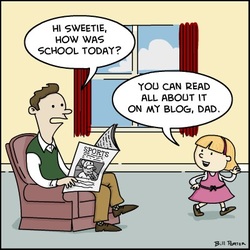
Throughout this course, I have learned a great deal about technology in the classroom. With the ever changing world, it is very important for both teachers and students to utilize new technologies as a way of reaching students. Although some of these technologies may not be practical in a classroom environment, I think the important part is that I was able to experiment and try something new. Throughout the 5 Week term, I have been exposed to many useful and cool technologies that I never knew existed.
One of the most important aspects of new technologies is its ability to expand creativity. Creativity is an essential component in a change from industrial model education to information age education. More than ever, students need to be creative, experiment, and fail. As such, this will allow them to constantly ask questions and become lifelong learners. Essentially all technologies mentioned during this course can allow students to be creative. Sites like Wordle, Xtranormal, and Weebly allow students to create and learn. Furthermore, I believe the skill-sets these technologies teach is much more important than the factual information we teach in the classroom. Having our students become creative thinkers and having them unafraid to take risks will benefit them exponentially in the job market and "the real world" (much more so than being able to list the causes of World War I).
Another very important aspect of technology is its collaborative nature. Wikis and Google Docs allow students to collaborate on works, create stuff, and learn. These can be great final projects that allow the students to have fun and learn. I also believe that collaborative learning is an essential component to constructivism. Rather than have the teacher simply tell the students what they need to know, the students decide for themselves what is important (and find the answers to their own questions). Collaboration is also important because each student has their own skill set and prior knowledge. As such, the students have the ability to bring their "forces" together to learn from each other in a successful manner.
As a teacher, I will make every effort to stay in touch with emerging technologies and use ones that I believe will benefit my students. It is my hope that through continuous experimentation, I will become a successful teacher and allow every student to reach their full potential.
One of the most important aspects of new technologies is its ability to expand creativity. Creativity is an essential component in a change from industrial model education to information age education. More than ever, students need to be creative, experiment, and fail. As such, this will allow them to constantly ask questions and become lifelong learners. Essentially all technologies mentioned during this course can allow students to be creative. Sites like Wordle, Xtranormal, and Weebly allow students to create and learn. Furthermore, I believe the skill-sets these technologies teach is much more important than the factual information we teach in the classroom. Having our students become creative thinkers and having them unafraid to take risks will benefit them exponentially in the job market and "the real world" (much more so than being able to list the causes of World War I).
Another very important aspect of technology is its collaborative nature. Wikis and Google Docs allow students to collaborate on works, create stuff, and learn. These can be great final projects that allow the students to have fun and learn. I also believe that collaborative learning is an essential component to constructivism. Rather than have the teacher simply tell the students what they need to know, the students decide for themselves what is important (and find the answers to their own questions). Collaboration is also important because each student has their own skill set and prior knowledge. As such, the students have the ability to bring their "forces" together to learn from each other in a successful manner.
As a teacher, I will make every effort to stay in touch with emerging technologies and use ones that I believe will benefit my students. It is my hope that through continuous experimentation, I will become a successful teacher and allow every student to reach their full potential.
